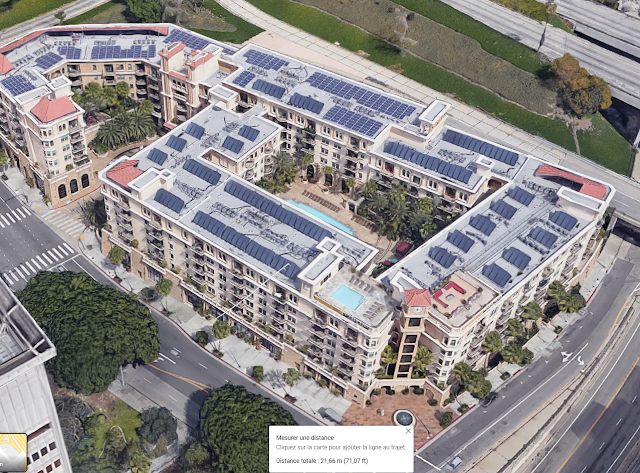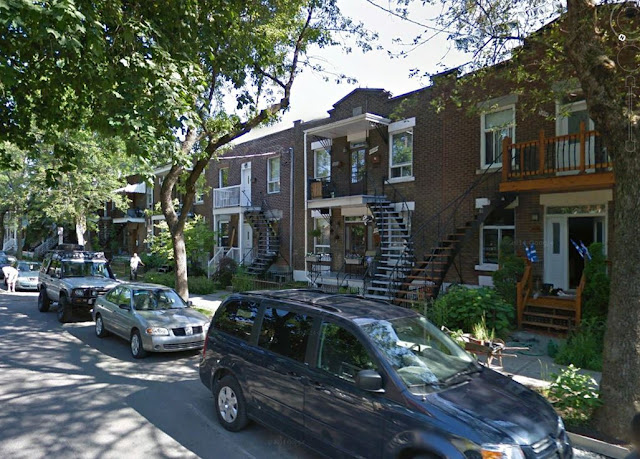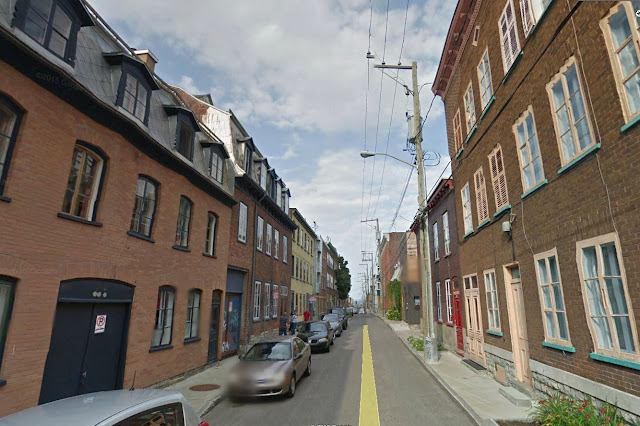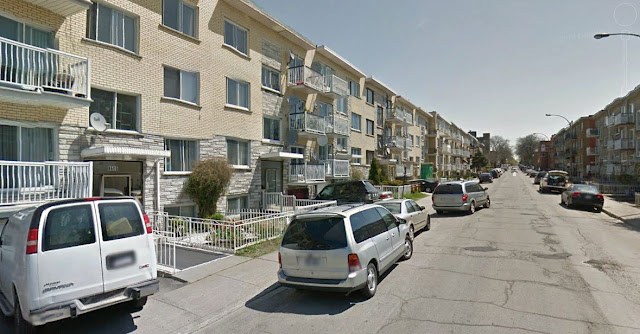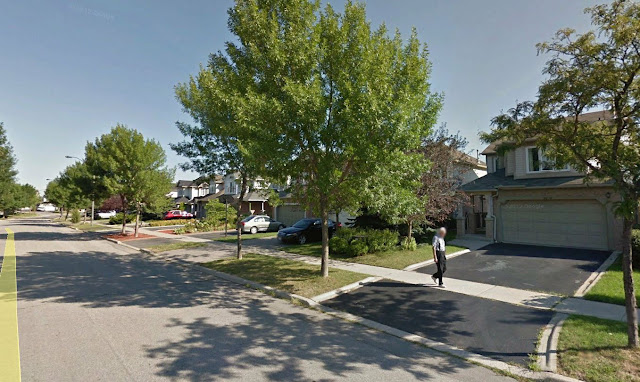So, I've recently discovered an interesting tool to visualize census data for Canada,
www.censusmapper.ca.
Among its various data, it allows to do visualization of population
density bloc by bloc (rather, census tract by census tract, but most of
them are bloc-sized). This made me want to do a kind of encyclopaedia of
density, for typical forms of development in Québec, and maybe a bit
from Canada too.
Why
Québec? Because I live here and Québec has a special focus on low-rise
developments lacking in a lot of North America. I may do one for
American developments one day, with city-data providing a similar tool
to explore population density bloc by bloc in the US.
Before going on, I'd like to point out a few things.
First,
there is the question "is there a density threshold for walkability?".
This depends on a lot of factors, and my own thinking on the subject has
led me
to doubt that residential density is even the most important factor.
Overall, though, I tend to consider that local walkability is highly
dependent on access to a modern supermarket, the most important and
frequently visited store for most people, of which there tends to be
about 1 per 8 000 to 12 000 people in North America and a 10-minute
"walkshed" is about 1 kilometer big. So a walkable neighborhood,
supposing a good design that maximizes walking speed, should have 8 000
to 10 000 people per square kilometer. Which comes down to 80 to 100
people per hectare.
Around
here, people also suppose that the minimum density to support
high-frequency transit is about 35 dwelling units per hectare, which
would be about 60 to 80 people per hectare.
Oh, and a quick summary for units.
4 people per acre = 10 people per hectare = 1 000 people per square kilometer = 2 560 people per square mile
I'll use people/units per hectare in the following.
OK, so let's get started.
Traditional Québec developments
Traditional village mix
50 to 70 people per hectare
30 to 40 dwelling units per hectare
This
is an old type of chaotic developments common to old villages, with
small detached single-family homes living alongside semi-detached homes,
duplexes and other low-rise multifamily buildings. What characterizes
it is the lack of uniformity, neither building line, nor architectural
style, nor building function are uniform. This is the orderly chaos of
developments pre-zoning.
Old single-family suburban areas
40 to 50 people per hectare
15 to 20 dwelling units per hectare
This
is a form often seen in older suburbs, a transitionary period between
the chaos of early villages and the strict planning of today's cities.
Lots tend to be about 15m x 30m (50' x 100'), front yards are more
common, rear alleys are extremely rare.
Old suburban areas, mix of houses and low-rise apartments
55 to 70 people per hectare
25 to 35 dwelling units per hectare
This
is present in some older suburbs that were built before strict
single-use zoning came about and that had a mix of homes and low-rise
apartments. As a result, zoning in these areas often allow both
single-family and multi-family uses, even today allowing for the
replacement of old houses by small condo buildings. In a way, this is
very similar to the old village mix, simply with a more orderly design,
with a clear building line, for instance, with front yards and more
regular spacing between buildings. Density is consequently very similar
between the two. Still the density here is not quite up to par with
highly walkable cities, it's a bit too low but it's pretty close and it
can justify adequate transit options. When they were built, people
tolerated smaller stores and more crowding per unit, so these were
highly walkable then.
Duplex developments
55 to 60 people per hectare
30 to 35 dwelling units per hectare
The
duplex is perhaps one of the most common types of buildings in
traditional Québec towns and villages, especially the squarish duplex
with exterior stairways, balcony and porch. Uniform streets of these are
relatively rare, but they exist, like this neighborhood in
Trois-Rivières. The density here is still at or a bit below the
threshold for minimum density. Traditional duplexes allowed people who
couldn't afford single-family houses to afford housing by building a
second story and renting it out, creating revenue that allows the owner
to afford his own unit. Duplexes also allow for more air and light for
every unit, with side windows made possible by each building being built
apart from one another and separated by a few meters. This also allows
for 1 or 2 parking spots to be built per unit, so even if you're in a
car-centric city, this form of development is viable, all without
violating some people's low-rise sensibilities.
Standalone triplexes
60 to 90 people per hectare
50 to 70 dwelling units per hectare
Standalone
triplexes aren't rare in older towns, but it's rare to have blocs full
of them. Shawinigan, a small town north of Trois-Rivières is one of the
rare cases I know of where this is a dominant typology of its older
neighborhoods. The population density could be higher if it weren't for
the fact that this city is in demographic decline and so housing is
cheap, allowing singles to rent big apartments. I'm not kidding, I
checked the rental ads for the town, you can get a 3-BR apartment in one
of the buildings on the picture for 400$ a month. Anyway, if properly
occupied, this typology would easily be favorable to walkable cities and
good transit. Also, contrast this image with the previous one to see
the impact street trees have on the beauty of a street.
Attached duplexes
120 to 150 people per hectare
60 to 75 dwelling units per hectare
This
is mainly seen in major cities that had streetcar suburbs. Montréal has
neighborhoods with this typology. It's a bit similar to the previous
duplexes, but instead of being squarish detached structures, these are
deeper than wide and built wall to wall. Otherwise, the concept is the
same. Since side spacing is eliminated, it allows for essentially a
doubling of density. We are well in the territory of the walkable city
here, and indeed neighborhoods with this typology in Montréal are
associated with strong neighborhood stores, high walk scores and low (30
to 50%) car commuting mode shares.
Attached triplexes

190 to 220 people per hectare
90 to 120 dwelling units per hectare
This
is like the previous case, but instead of being limited to 2 stories,
you have 3. Obviously, this results in a 50% boost to density and
creates very high density. This doesn't provide more parking than
the attached duplexes of the previous example, while density is
boosted. So it won't satisfy suburban parking requirements and it will
yield lower car mode shares, simply because it's next to impossible to
maintain universal car ownership due to the lack of parking spot. Many
Montréal neighborhoods include a mix of 2-story and 3-story attached
buildings, and have density between these two examples of uniform duplex
and triplex developments.
European-style blocs
200 to 280 people per hectare
120 to 150 dwelling units per hectare
Yes,
these do exist in North America. Very rare, but you can find them in
the Vieux-Québec area of Québec City. Tightly packed 2- and 3-story
buildings with high lot coverage. Very high density, very few parking
spots and narrow streets. Nice to visit, more debatable how nice to live
in considering the proximity of buildings both in front and in back.
Modern and transitional developments in Québec
These
are developments made since the advent of mass motorization, often, but
not always, with parking. These developments often incorporate modern
construction techniques, whereas the traditional developments didn't.
Usual bungalow developments

25 to 30 people per hectare
10 to 13 dwelling units per hectare
This
is the usual sprawl-type development in suburbs all around Québec.
Generally wide (20m x 35m) plots with wide 1-story houses (with livable
basements) and driveways. Density half to a third that of traditional
villages and even 30 to 50% less than earlier single-family suburbs. Far
from density thresholds for walkability and for transit services.
Suburban semi-detached homes
50 to 65 people per hectare
20 to 25 dwelling units per hectare
This is a type of housing present in some suburbs. It's rare for it to be the dominant housing type as in the case of the neighborhood there, but it offers more affordable suburban housing options that remain palatable to people looking for suburban living. It's single-family housing, with plenty of parking, a front yard and a back yard, just sharing one exterior wall with a neighboring house, with both houses built on a single bungalow lot, doubling density. To compensate for the smaller building footprint, the houses usually have two stories plus an inhabitable basement.
Suburban narrow homes
65 to 75 people per hectare
20 to 25 dwelling units per hectare
These are new developments in suburbs, largely the result of density targets in areas targeted for "TOD" development according to the Metropolitan Community of Montréal. Single-family houses built as densely as possible while retaining suburban sensibilities, including driveways and garages. The result: a front yard that is more pavement than grass, with little place for trees.
Suburban condo triplexes

70 to 80 people per hectare
35 to 45 dwelling units per hectare
This is a relatively recent development (over the past couple of decades) in some suburbs. Standalone triplex condos built on single-family lots. Another example of how more affordable housing and more density can be added to a suburban neighborhood without breaking the single-family lots. The need for parking however results in a very high proportion of the lot being paved over for parking. The lack of private front or back yards reduces the attraction of these housing types for families, resulting in lower numbers of people per unit than semi-detached.
3-story condo or apartment buildings
60 to 90 people per hectare
45 to 60 dwelling units per hectare
This
is a type of low-rise apartments often built in suburbs. Some are
apartments for poorer residents, others are more upscale for the middle
class and sold as condos. They offer similar density to tradition
isolated duplex neighborhoods or traditional village mixes, but offer a
lot more parking. They also have bigger setbacks and thus maintain air
and light in a way that is tolerable for the suburban-minded. As they
tend to have little or no underground parking, instead opting for
parking lots, they are quite cheap to build.
Dense low-rise suburban apartment or condo complexes
100 to 120 people per hectare
80 to 90 dwelling units per hectare
This
is more or less the maximum density you can get while respecting
suburban parking requirements without getting into mid-rise or high-rise
territory and without resorting to massive underground parking to keep
costs down. This density is sufficient to provide for walkable
neighborhoods and to sustain transit lines. However, the quantity of
parking lots they generate reduces the desire to walk and makes it easy
for people to opt to own and use cars.
Attached duplexes built over garages
140 to 160 people per hectare
55 to 65 dwelling units per hectare
This
is essentially the traditional attached duplex neighborhood adapted to
the car era, with slip-under, front-loading garages to satisfy parking
requirements. The result is that they retain the old duplexes' density,
but at a cost of comfort to walk and of street design. The massive
driveways mean frequent curb cuts making walking less comfortable and
reduces trees and grass to a minimum, making the area less hospitable to
human beings. The number of units per hectare here isn't all that high,
but the location of these buildings near Montréal, the size of the
units, the private door and the back yard all result in a high number of
occupants per unit, and thus higher population density than the
isolated low-rise apartments in the two previous types.
Modern townhouses
100 to 130 people per hectare
40 to 45 dwelling units per hectare
This
is a rare form of modern townhouses present in a few areas. Its
modernity is not just in its architectural style, but in the parking
present below the back yard's porch, with a driveway sloping down
between each group of townhouses. This is an innovative attempt at
reconciliation of the car-centric development but with an urban face,
limiting curb cuts and preserving front and back yards while still
offering at least one parking spot in a garage per house. However, it's
not particularly affordable and its design over 4 stories (basement, 1st
floor, 2nd floor and 3rd floor) means a lot of stair-climbing for every
member of the family. No need for a Stairmaster with a house like that.
Attached modern walk-up apartments
330 to 380 people per hectare
140 to 160 dwelling units per hectare
I
wasn't sure whether I should have included this in traditional or
modern developments. On one hand, its architecture style is reminiscent
of the duplexes built over garages and there are some driveways and
garages present, at the same time, it clearly offers way less parking
than most other modern developments. Anyway, this is, as far as I'm
aware, the densest low-rise area in Montréal, located in Parc-Extension.
These are effectively 4-story buildings as the basement has units too.
It's also a particularly poor area, populated by recent immigrants for
the most part, so it has higher than average number of occupants per
unit.
Modern planned mid-high-rise condos
350 to 500 people per hectare
250 to 300 dwelling units per hectare
This
is a form of planned condo development on old disaffected industrial
grounds. The planning is very evident and show bloc-sized planning, with
huge garages in the interior of the blocs being covered by parks for
the enjoyment of the residents, though the park is not visible from the
street as it is elevated a couple of stories up. The high cost per
square foot and deep building results in a very high amounts of units,
as most of them are studios or 1-bedroom apartments. It's good density
but that doesn't help life on the street as much as previous eras
duplexes and triplexes.
High-rise compact developments, the top of Montréal density
800 to 1 200 people per hectare
500 to 800 dwelling units per hectare
I
couldn't avoid mentioning the highest density blocs of Montréal that I
know. These are high-rise apartments located near Concordia university
in downtown Montréal. These are not only high, they have pretty high lot
coverage, for a very high population density. This is the kind of
development you can barely imagine anywhere else but there, to satisfy
students' requirements for housing. The use of the ground floor for
retail and restaurants also helps attract and retain people to the area,
unlike the pretty sterile modern condos shown in the previous type.
So
here you go, an overview of densities present in Québec, from
traditional villages with isolated buildings to modern developments.
This can provide a good idea of the possible ways to achieve a density
that is sufficient for walkability and transit use, and how high-rises
are not necessary to achieve sufficient density.
Select typologies from the RoC (Rest of Canada)
So
this was a description of some housing typologies found in Québec, both
traditional and modern. But Canadian cities can be a bit different,
they're more like American cities in some ways, often with a focus on
single-family housing and bigger tenement buildings.
Traditional urban homes - low density (Hamilton)
45 to 60 people per hectare
20 to 25 dwelling units per hectare
For
anyone who knows American small towns, this is nothing new. These are
detached homes built close to one another but not sharing walls, on
narrow but deep lots, a typology of urban housing extremely common in
anglo North America. The density isn't quite high enough for walkability
today, but once upon a time, you could have expected many of these
homes to have taken in boarders. Today, this is extremely rare and
families are smaller, so population density is probably much lower than
100 years ago.
Traditional urban homes - high density (Hamilton)

80 to 100 people per hectare
35 to 45 dwelling units per hectare
This
is just a denser form of the previous, with even narrower lots and
homes nearly touching, with barely enough space for a man to walk
between them. The density here is similar to Japanese single-family
house neighborhoods and is actually sufficient for a walkable
neighborhood and adequate transit services.
Toronto traditional urban homes and semi-detached
100 to 130 people per hectare
45 to 55 dwelling units per hectare
This
is the traditional form of development in Toronto, the equivalent of
Montréal's duplex neighborhoods, except instead of relatively wide
duplexes on shallow lots, these are detached and semi-detached homes
that are very narrow on very deep lots.
Modern snout houses (Mississauga)
60 to 100 people per hectare
15 to 30 dwelling units per hectare
Just
like Montréal has duplexes built over garages which are an adaptation
of its traditional duplex type of housing, anglo-Canada has a modern
adaptation of the old narrow and deep urban home... the snout house.
Thus named because of the protruding garage doors that look like a snout
and reduces front-facing windows to a minimum. Note that the population
density here is uncommonly high considering the number of dwelling
units. We're approaching 4 people per household on average, versus 2,5
on average in Québec single-family housing. I don't know why that is,
but that ratio is high all across Mississauga, at least, in that area.
Is it an ethnocultural community that has unusually high fertility
rates? Is the price of housing pushing people to live with their parents
and children longer? I don't know.
Traditional low-rise apartments (Hamilton)
110 to 130 people per hectare
70 to 90 dwelling units per hectare
This
is a relatively rare case of an old type of density in an old
Anglo-Canadian city (Hamilton). As the lots are narrow and deep and
buildings are detached, you can see some areas where, among the old
urban homes, you can spot narrow and long apartment building 3 to 6
stories high. However, this process seems to have been interrupted by
the arrival of modern zoning practices and parking requirements. It's
interesting to note the difference between low-rise apartments in Québec
and in Anglo-Canada, with Québec having small low-rise apartments built
wall to wall, often owned by one of the occupants, without the need of a
lot of capital to own it, and Anglo-Canada having bigger apartment
buildings that were probably owned by richer owners who resided somewhere else.
Urban high-rises
250 to 400 people per hectare
200 to 300 dwelling units per hectare
I
know of nothing else that can showcase the lack of middle housing in
Anglo-Canada than this. High-rise apartment buildings carved out of old
neighborhoods of urban homes, resulting in 2-story urban homes being
next to 20+-story apartment buildings with underground parking. This is
probably the stuff of nightmare of most NIMBYs... and even of a ton of
urbanists, I suppose. I would be curious to know the value of the
remaining homes next to the high-rises, to see if their value is higher
or lower than similar homes a bit further away, just to test the theory
that high constructions depress the value of neighboring low-rise
single-family properties. Anyway, very high density nonetheless, almost
Paris-level density in some areas.
Vancouverism (do I need to say where?)
500 to 800 people per hectare
350 to 500 dwelling units per hectare
Vancouverism
is the name used to describe the style of development that forms the
basic pattern of Vancouver's downtown. Funnily enough, it's not unlike
the previous chaotic development in Hamilton in that it combines
low-rise and high-rise developments on the same bloc. The difference is
that Vancouverism is more ordered than what we see in Hamilton's central
neighborhood, building lines are more respected, the placement of the
skyscrapers resembles a checkerboard, to prevent buildings from cutting
light and air access to one another and to avoid a trench feeling for
people on the street. The density level is probably among the highest in
the Western world, equaling or topping the dense neighborhoods of
Barcelona and Paris. This is Manhattan Upper East Side levels of
density. The main issue of such development is cost, as skyscrapers are
not affordable to build at all. Vancouver's out of control housing
market makes such development possible, but that may not be the case
everywhere.
Conclusion
OK,
so this was just a catalog of density of different development patterns
seen in Québec and the rest of Canada. I don't claim this list to be
exhaustive. I think it may be useful to have such a catalog to know what
different levels of density look like and to lay to rest some ideas.
Thus, both the idea that you HAVE to go very high to achieve
walkability-supporting density (when even 2-story developments with
detached buildings can approach that threshold) and that there is no
point to go very high because lower lot coverage means you won't get
more floor space are wrong.




















